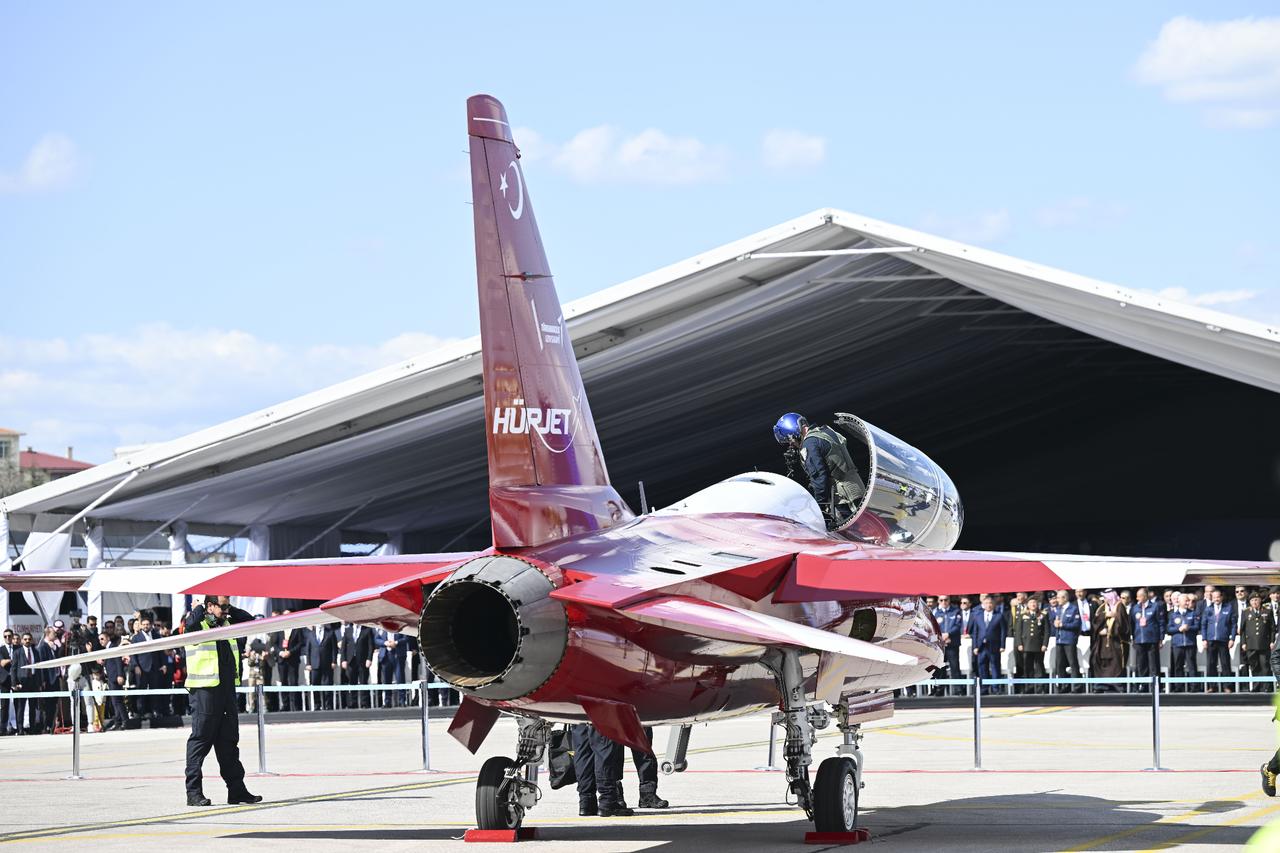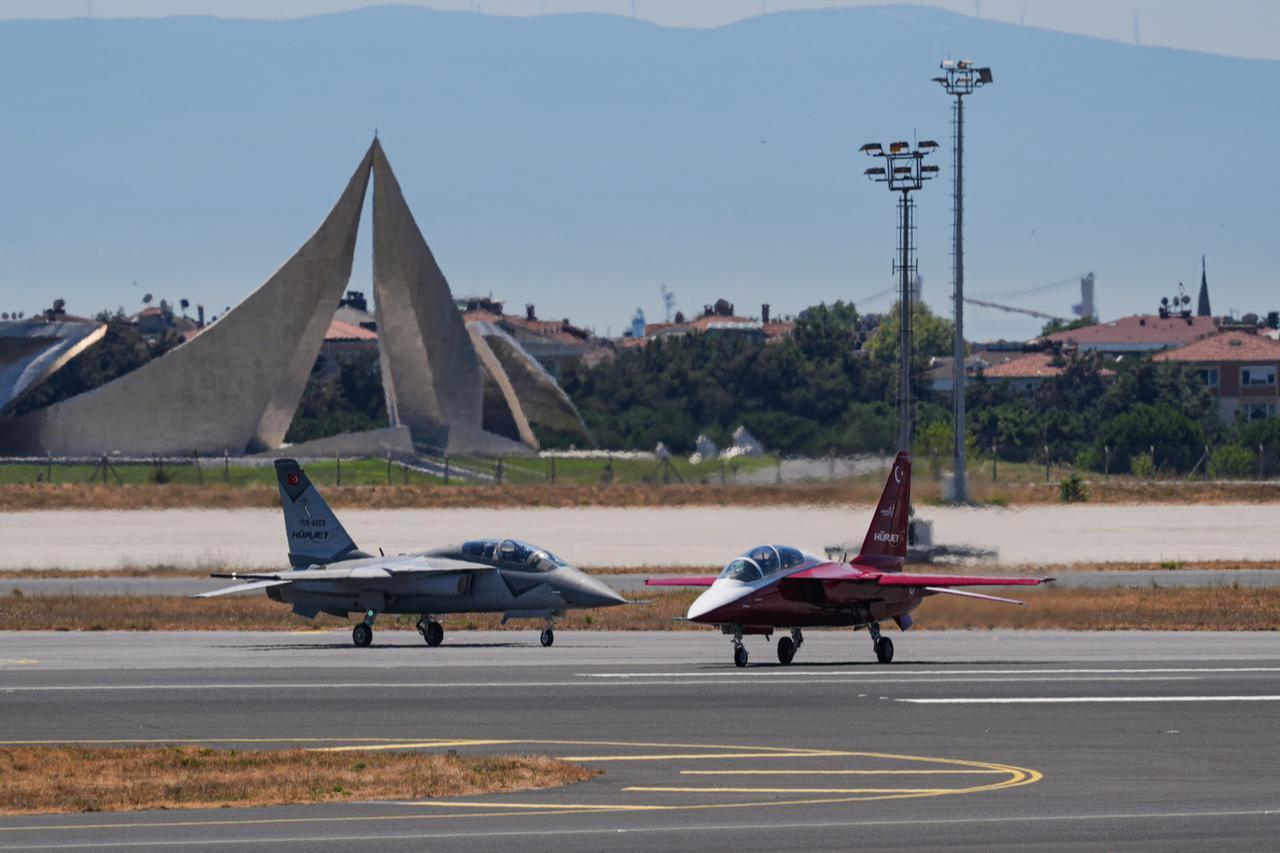
Last week’s major news on Türkiye’s Eurofighter Typhoon acquisitions eclipsed another critical development—the sale of the Turkish-made Hurjet advanced trainer jets to Spain.
The Spanish purchase of the aircraft, under development with Turkish Aerospace Industries (TAI, aka TUSAS), could open new doors for Türkiye’s dynamic defense industries and for potential Turkish-European cooperation in pilot training and joint exercises.
Following U.K. Prime Minister Keir Starmer’s visit to Ankara on Oct. 27, announcing the Typhoon sale, Spain’s Prime Minister Pedro Sanchez and his cabinet announced on Oct. 28 that Madrid will buy 45 Hurjets for the Spanish Air and Space Force for a total cost of €3.1 billion, or about $3.5 billion.
The Turkish and Spanish governments signed a memorandum of understanding in late 2024 to begin discussions on the sale. Spain was expected to acquire about 28 or 30 of the Turkish aircraft for €275 million ($309.5 million), according to The Aviationist.
The considerable increase in the price tag can be explained by the involvement of Airbus Defense and some 15 defense firms from Spain to develop radars and avionics for the Spanish Hurjets by investing in the Turkish production line and Spain obtaining munitions and additional equipment from the Turkish side.

Hurjet is a single-engine, supersonic aircraft that will replace both the T-38 trainer jets in the Turkish Air Force as well as the F-5 Freedom Fighters used by the Turkish Stars, the force’s acrobatics team.
Similarly, Hurjets will take over from the F-5s in the Spanish military. In time, the aircraft is expected to take on ground attack and even air-to-air missions. It is scheduled to go into production in late 2026, with expected first deliveries to Türkiye in 2027 and to Spain sometime in 2028.
Ankara’s Hurjet deal with Madrid is additionally impressive because it is the first time that the Turkish aircraft overtook other trainer jets in international tenders, such as the Korea Aerospace Industries’ T-50 Golden Eagle and Italian Leonardo’s M-346, which have sold several hundred units in export markets.
Beyond the sales to the Turkish and Spanish air forces, defense circles in Türkiye are weighing the merits of developing a “Super Hurjet”—a twin-engine naval version that could operate from aircraft carriers.
One of the open secrets in Ankara and Madrid is that their navies and defense industries are discussing ways to develop a dedicated aircraft carrier, a move that would replicate the two countries’ success in developing the Turkish Navy’s flagship, the amphibious assault ship TCG Anadolu, itself based on the Spanish firm Navantia’s Juan Carlos-class ships.
Similarly, some defense experts told this author that given Türkiye’s purchase of the Eurofighter Typhoon and Turkish drone giant Baykar’s acquisition of Italy’s venerable aviation company Piaggio Aerospace earlier this year, there is an opportunity for the Turkish and European sides to cooperate on developing new manned and unmanned systems and their critical components.

While the near-simultaneous announcements regarding the Typhoon and the Hurjet give a sense of “quid pro quo” between Türkiye and Europe, the cooperation could develop further.
One idea in Ankara is to build a dedicated pilot training center to train students from friendly nations, which could include an airbase for joint exercises.
Originally floated by retired Turkish Air Force brigadier general and fighter pilot Huseyin Fazla, who currently heads the Ankara-based think tank STRASAM, the idea involves student pilots training first on the TAI-made basic trainer Hurkus, then receiving advanced training on the supersonic Hurjet, and then possibly gaining experience with warplanes such as the Typhoons, F-16s, and others before going back to their countries to operate those platforms.
The idea is not at all far-fetched—in fact, one location could serve that objective.
During Türkiye’s economic boom years in the 2000s and 2010s, the government carried out massive investments in new infrastructure, including airports, but several projects ended up not being as profitable.
One example, Zafer (“Victory”) Airport, aptly named so because of its proximity to historic battlefields from the Turkish War of Independence (1919-1923) in the province of Kutahya, could be repurposed for such an objective more befitting of its name.
One challenge for TAI will be exporting Hurjet to countries outside Europe because the aircraft is powered by a US-made General Electric F404 engine.
Given that most European countries are now NATO allies, Washington is unlikely to block the sale of the Turkish aircraft in Europe. But the US side has blocked the sale of TAI’s T129 attack helicopters to Pakistan in the past, and there is no reason why it would not do so in the future for other Turkish platforms—especially if the Hurjet could carry out combat missions.
While TAI’s engine subsidiary, TEI, is working on an engine to replace the GE F110-129s that will go on Türkiye’s fifth-generation national combat aircraft, MMU KAAN, it is not clear if there are similar plans for Hurjet engines.
One idea is for the TEI’s TF-10000 series engines, currently under development, to be integrated onto the Hurjet, an idea that will become even more pressing if the twin-engine “Super Hurjet” becomes a reality.
That opens the question of whether Spain might be interested in the KAAN.
After all, Madrid decided not to acquire the Lockheed Martin F-35 from the United States.
While there have been no official overtures from Madrid to Ankara on this front, industry experts argue that the Spanish side will be closely following the performance of KAAN’s new prototypes that are scheduled to begin testing in 2026, along with their satisfaction with the Hurjets they acquire.
If the full integration of TEI’s TF-35000 engines for the KAAN takes a few years longer than expected—producing a full-fledged engine takes as much time as an aircraft—that would also affect Spanish and overall European interest in the next frontier in Türkiye’s air and space sector.
Hurjet signifies the continuation of a beautiful friendship between Ankara and Madrid.
Where they take it from here will have a considerable impact on Europe’s and NATO’s defense and security considerations.